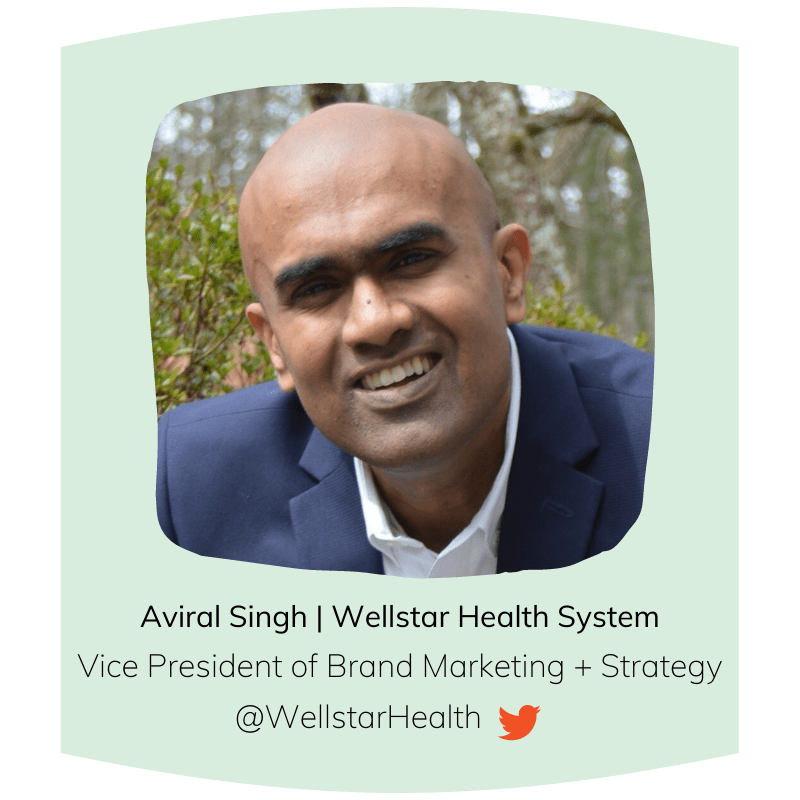A Check-up on the Healthcare Industry in 2020
During this time of uncertainty, we’ve spoken to a number of marketers in a variety of industries including Restaurants, B2B, IT and Services, Hospitality, and Entertainment. We’ve also discussed ecommerce and paid media trends with marketing leaders as reliance on digital marketing efforts increase.
Since COVID-19 has uniquely impacted the Healthcare industry in particular, we reached out to some marketing Healthcare experts to get their perspective on the following:
What is your team’s process to develop messaging that educates the consumer and creates transparency?
How does technology affect your consumers and team? What technological advancements are most beneficial to marketers in the Healthcare industry?
How have ratings/reviews affected your overall marketing strategy when it comes to developing a reputation?
How has COVID positively and negatively affected your industry?
What trends are you expecting to see in the upcoming months/2021?
What's a non-Healthcare focused brand that can teach your industry something new?
#1 - What is your team’s process to develop messaging that educates the consumer and creates transparency?
Transparency within Healthcare, especially during a global pandemic, is imperative. Allie Clark, the SVP Director of Client Services at Blue Sky Agency, and David Luick, the Vice President of Sales and Marketing at Tungsten Medical Network, shared that the root of all messaging comes down to having a consumer-centric approach that is honest and builds trusts.
Clark, who works with an agency and was speaking on behalf of her Healthcare clients, broke down their messaging process:
“Research that we’ve done in partnership with our client helps us identify the topics that are most important to consumers in the Healthcare space. We start with broader messages that address scale and quality, and then we layer in more targeted channels to deliver the information unique to their condition and demographics. This empowers consumers and builds their confidence in the information they are seeking. The messages we develop are also aligned with ways we can truly deliver on patients’ needs - we make sure to stay true to brand strengths to enhance our credibility. This helps us overcome the fear and skepticism consumers feel today, and builds trust.”
Building trust has been a key motivator during COVID. Blue Sky adjusted messaging accordingly. “We saw what our community needed most from us: strength, resilience and facts on how to keep their family safe and protected. Community commitment is a strength for us, so we took the opportunity to show people that we were committed and that they could have hope.”
“We took the opportunity to show people that we were committed and that they could have hope.”
“Transparency is not just a goal at Tungsten,” shared Luick. Tungsten Medical Network provides transparency throughout the consumer journey by doing the following:
Publish prices online, and don’t artificially discount the products so that everyone pays the same price for the same product.
Include spreadsheets to compare features and benefits of the products to competitors in a fair and honest way.
Treat customers as partners and do not recommend they buy anything they don’t need.
“When we build trust with our partners, they can rely on us to do right by them.”
#2 - How does technology affect your consumers and team? What technological advancements are most beneficial to marketers in the Healthcare industry?
Debra Bass, the U.S. President and Global CMO of Nuvo Group, believes that technological advancements in the consumer journey for Healthcare have been minor over the years, but, due to COVID, are picking up.
She shared, “Healthcare is still catching up to the benefits of foundational technology more widely deployed and entrenched in other parts of a consumer’s life. Specifically, the introduction of the iPhone in 2007 gave consumers a gateway to the world in terms of real time connection, access, and exposure to a global community and marketplace of products and services. The introduction and continued expansion of e-Commerce, digital/social channels, and DTC brands fueled new possibilities of on-demand access, personalized experiences, and pricing transparency across almost all consumption categories. Importantly, the advent of the Digital Age has indelibly ignited new consumer expectations that Healthcare is lagging to address.”
Technology does play a role in Healthcare by:
Improving the patient/physician relationship
Because of telehealth and information easily accessible via search, patients are more informed and empowered as well as connected to their physicians. Clark shared, “Digital technology has given consumers unprecedented access to Healthcare information. Over 80% of consumers now research medical conditions and treatments, the majority of which happens via a search engine. This has created a few favorable conditions for consumers, one of which is the improved patient/physician relationship. A 2015 study found that patients who began treatment after having obtained online information were more likely to feel empowered and have a positive physician interaction.” Patients no longer feel in the dark and can gain clarity about their symptoms and diagnosis.
Bass shared that telehealth has been monumental to connecting at-risk patients with their doctors during the pandemic and will likely transform services and accessibility moving forward. “The COVID-19 pandemic has served as a lightning rod for telehealth adoption broadly. In the case of pregnancy care, it has elevated remote pregnancy monitoring from an unmet to an acute need as clinics closed and/or have restricted access. Pregnant women are deemed a ‘vulnerable population’ who are encouraged to socially distance yet they can’t go unchecked from a care continuity standpoint. Nuvo Group is enabling distributed care into the home at a time when it’s needed most. There will be no turning back to the ‘old way’ (e.g., inconvenient brick and mortar pregnancy care) as expectant moms continue to reap the benefits of a better and safer way to receive their care.”
Improving the connection between consumers + information
“Advances in technology are impacting all aspects of the Healthcare journey. Increasingly, consumers are using and expecting technology-enabled services such as online appointment scheduling, virtual appointments, access to online medical records, knowledge e-libraries focused on health conditions etc. For consumers, advancements that drive convenience and a higher sense of control tend to be more popular,” shared Aviral Singh, Vice President of Brand Marketing and Strategy at Wellstar Health System.
“Technology has given marketers an additional avenue to connect with consumers and provide them with better information in an easier manner,” Clark added. “Marketers who play a role in helping consumers navigate information and available providers will be successful in building their Healthcare brand and creating long lasting consumer relationships.”
Luick stated that technology has increased communication between consumers and the service team - ensuring the consumer is informed as quickly as possible. “When an inquiry comes in, our entire service team receives it, and it’s a race for the first person to respond. Most inquiries can be remedied remotely from a mobile device in seconds, which is critical when patient care is at stake.”
“In the case of Pregnancy Care,” Bass added, “Millennial moms expect and deserve to be empowered with digital tools and more convenient access to care to shape and navigate their best pregnancy journeys, experiences, and outcomes.” Technology provides consumers with Healthcare education, online communities and marketplaces, and digital care navigation services.
Bass continued, “In the case of Nuvo, we are leaning into this unmet need by creating a new platform to enable mother centered, medical grade pregnancy monitoring and management. This platform combines new proprietary technology (e.g., a sensor band to capture fetal heart rate and contractions as one component) with existing tech and tools such as the smartphone, telehealth infrastructure, and the power of cloud computing to introduce a world of “connected pregnancy” and make mothers the point of care in expanding access (to both monitoring and knowledge (e.g., high fidelity data)) and enabling more distributed care across the home, the office, and hospital environments.”
Leading to medical advancements
“The most desirable technological advancements shall always be those that help improve patient outcomes,” Singh stated.
“The use cases are vast and varied; for example: use of AI to analyze diagnostic imaging, remote monitoring of symptoms that could signal presence of disease. Many of the new tools require shifts in mindset for caregivers and consumers, and appropriate regulation.”
#3 - How have ratings/reviews affected your overall marketing strategy when it comes to developing a reputation?
Good quality speaks for itself, and Luick and Clark emphasized this.
Luick shared that they have their customers digitally sign their reviews on Google to build credibility. “It is easy for us to say we have the highest quality product, so we let our customers promote that message for us. This allows us to focus more on our customers and less on marketing.”
Clark says their focus on overall quality is measured by patient satisfaction surveys. “Our 95% patient satisfaction score speaks volumes about the consistency of the quality of care we offer. That is very motivating to audiences and the larger company focuses many initiatives on ensuring that remains true. Consumers really trust this type of ‘review’ - they feel they will be cared for at the highest level.”
A good reputation and quality care is also reflected in partners. Clark added, “We align ourselves with partners who are seen as authorities with high levels of integrity. This helps increase the credibility of the work we do and the information we share.”
#4 - How has COVID positively and negatively affected your industry?
Positives of COVID + the Healthcare Industry
Increased community involvement
Clark, like many industry marketers we’ve interviewed in the past, emphasized that COVID has led to more community involvement and connection. “We play a big role in our community - and COVID increased that tenfold. We focused on sending a message of strength, resilience and commitment to providing support to those who needed it. With so many debates raging, we focused on the science over the politics and were able to remain consistent in our messages to consumers. We paused many of our paid channels and turned our social and digital feeds to ongoing content that helped our community navigate the day to day practical aspects of staying safe and seeking care when needed.”
Increased use in telehealth
Claire Russell, the Head of Media at Fitzco, noted that people across all populations and demographics have access.
Increased cleanliness + shared accountability
“Public spaces, events, workplaces, restaurants have all become more accountable for managing the health and safety of their respective offerings. Consumers too are paying more attention and are more proactive than ever. This shared accountability takes some pressure off the Healthcare system and is likely to have long term impacts on preventive care,” Russell shared.
Negatives of COVID + the Healthcare Industry
Lack of attention to other health issues
Because patients are too worried about COVID and nervous to go to health facilities, people are failing to get preventative screenings and checkups. This is not only dangerous for the patient’s health, but also for the Healthcare employees and business. Russell shared, “COVID has created a great deal of fear around getting treated for milder symptoms/conditions, elective surgeries, etc. Hospitals especially are hugely reliant on the revenue from these services and their operational efficiencies of being able to schedule these as needed.”
Moving forward, the Healthcare industry needs to emphasize safety standards to build trust with the people. Clark stated, “As COVID has continued, it’s important that we get consumers back to thinking about other potential health issues like cancer screenings, heart health and more. We must help consumers continue to protect their overall health beyond COVID, so that is the next phase we’ve entered into.”
Healthcare staff at risk
The unpredictability and viral component of the virus puts those who treat it at risk which leads to downstream staffing challenges for Healthcare providers.
Equalizer in the market
Any competitive advantage a hospital may have for having a supreme in-person experience has been taken away due to COVID. Russell described it as “an equalizer of sorts, where even a tent with a drive thru can suffice.”
#5 - What trends are you expecting to see in the upcoming months/2021?
Increase in telehealth
Since the capabilities and accessibility of telehealth have been demonstrated, the virus’ longevity is uncertain, and consumers value convenience, virtual health visits are most likely here to stay.
Clark believes more telehealth options and business models will be available. “COVID taught us that we can do pretty much everything virtually. This will accelerate the telehealth trend.”
“COVID taught us that we can do pretty much everything virtually.”
Singh pointed out that as virtual care increases in popularity, marketing messaging and channel priorities will adjust accordingly.
Health mindfulness
The “new normal” is a more health-conscious one. People are more mindful than ever about washing hands and sanitizing surfaces. “Wearables continue to evolve. Consumers have had to work harder to be more mindful of their health and activity level during COVID. These habits will stay with us,” predicts Clark.
High patient expectations
“The expectations around patient experience are at an all time high, and the tools to make someone feel cared for via telemedicine vs. seeing a nurse or doctor in person are limited,” shared Russell.
Increase in mental health awareness
Mental health is an increasing concern. Russell mentioned that mental health visits are making up nearly 1/3 of the virtual visits. As the world moves forward, the healthcare industry will remain focused on providing support and resources.
Increase in trust
“Healthcare brands have seen elevated levels of affinity and trust during the pandemic,” stated Singh. An increase in trust means Healthcare professionals need to work hard to provide factual information. “A large chunk of consumers remain concerned about visiting Healthcare providers for safety reasons,” he continued. “We don’t know where consumer sentiment shall be after a vaccine is available; it is possible that assurance messaging might be required for several more years.”
#6 - What's a non-Healthcare focused brand that can teach your industry something new?
Singh admired the innovation from food categories during this time. He mentioned, “It has been fascinating to watch the mini-revolution in many food categories where numerous smaller brands have emerged to cater to the growing consumer affinity for organic options while larger, entrenched brands, tied to inflexible supply chains, atrophy and decline. There are lessons here for the Healthcare industry to continue to operate with consumer-centricity and actively innovate to avoid being disrupted.”
Just as most industries are transforming at this time, Healthcare is uniquely positioning itself to offer virtual services and continually build trust with the public. Going into 2021, messaging and offerings will continue to adjust to align with consumer needs and behavior.















Over the past year, we’ve watched the following patterns emerge across seemingly unrelated sectors: rising consumer expectations, demand for authenticity, growing complexity, and the tension between automation and human connection.
We interviewed multiple marketers from an array of industries in our blogs below, and we discovered consistent trends across the board. Check out all of our industry blogs throughout 2025 from leaders at Blackbaud, Hiscox USA, Mimedx, MONPURE, Kimberly-Clark Professional, and more.